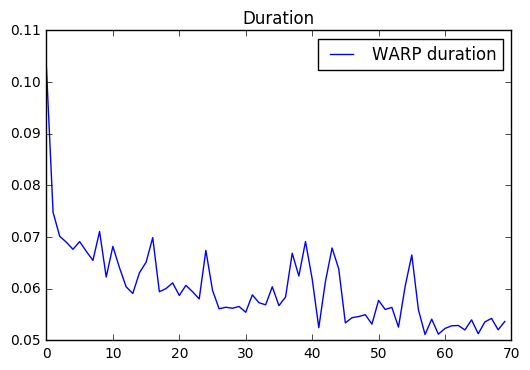Learning-to-rank using the WARP loss
LightFM is probably the only recommender package implementing the WARP (Weighted Approximate-Rank Pairwise) loss for implicit feedback learning-to-rank. Generally, it perfoms better than the more popular BPR (Bayesian Personalised Ranking) loss — often by a large margin.
It was originally applied to image annotations in the Weston et al. WSABIE paper, but has been extended to apply to recommendation settings in the 2013 k-order statistic loss paper in the form of the k-OS WARP loss, also implemented in LightFM.
Like the BPR model, WARP deals with (user, positive item, negative item) triplets. Unlike BPR, the negative items in the triplet are not chosen by random sampling: they are chosen from among those negatie items which would violate the desired item ranking given the state of the model. This approximates a form of active learning where the model selects those triplets that it cannot currently rank correctly.
This procedure yields roughly the following algorithm:
For a given (user, positive item pair), sample a negative item at random from all the remaining items. Compute predictions for both items; if the negative item’s prediction exceeds that of the positive item plus a margin, perform a gradient update to rank the positive item higher and the negative item lower. If there is no rank violation, continue sampling negative items until a violation is found.
If you found a violating negative example at the first try, make a large gradient update: this indicates that a lot of negative items are ranked higher than positives items given the current state of the model, and the model must be updated by a large amount. If it took a lot of sampling to find a violating example, perform a small update: the model is likely close to the optimum and should be updated at a low rate.
While this is fairly hand-wavy, it should give the correct intuition. For more details, read the paper itself or a more in-depth blog post here. A similar approach for BPR is described in Rendle’s 2014 WSDM 2014 paper.
Having covered the theory, the rest of this example looks at the practical implications of using WARP in LightFM.
Preliminaries
Let’s first get the data. We’ll use the MovieLens 100K dataset.
import time
import numpy as np
%matplotlib inline
import matplotlib
import numpy as np
import matplotlib.pyplot as plt
from lightfm import LightFM
from lightfm.datasets import fetch_movielens
from lightfm.evaluation import auc_score
movielens = fetch_movielens()
train, test = movielens['train'], movielens['test']
Accuracy
The first interesting experiment is to compare the accuracy between the WARP and BPR losses. Let’s fit two models with equivalent hyperparameters and compare their accuracy across epochs. Whilst we’re fitting them, let’s also measure how much time each epoch takes.
alpha = 1e-05
epochs = 70
num_components = 32
warp_model = LightFM(no_components=num_components,
loss='warp',
learning_schedule='adagrad',
max_sampled=100,
user_alpha=alpha,
item_alpha=alpha)
bpr_model = LightFM(no_components=num_components,
loss='bpr',
learning_schedule='adagrad',
user_alpha=alpha,
item_alpha=alpha)
warp_duration = []
bpr_duration = []
warp_auc = []
bpr_auc = []
for epoch in range(epochs):
start = time.time()
warp_model.fit_partial(train, epochs=1)
warp_duration.append(time.time() - start)
warp_auc.append(auc_score(warp_model, test, train_interactions=train).mean())
for epoch in range(epochs):
start = time.time()
bpr_model.fit_partial(train, epochs=1)
bpr_duration.append(time.time() - start)
bpr_auc.append(auc_score(bpr_model, test, train_interactions=train).mean())
Plotting the results immediately reveals that WARP produces superior results: a smarter way of selecting negative examples leads to higher quality rankings. Test accuracy decreases after the first 10 epochs, suggesting WARP starts overfitting and would benefit from regularization or early stopping.
x = np.arange(epochs)
plt.plot(x, np.array(warp_auc))
plt.plot(x, np.array(bpr_auc))
plt.legend(['WARP AUC', 'BPR AUC'], loc='upper right')
plt.show()

Fitting speed
What about model fitting speed?
x = np.arange(epochs)
plt.plot(x, np.array(warp_duration))
plt.plot(x, np.array(bpr_duration))
plt.legend(['WARP duration', 'BPR duration'], loc='upper right')
plt.show()

WARP is slower than BPR for all epochs. Interestingly, however, it gets slower with additional epochs; every subsequent epoch takes more time. This is because of WARP’s adaptive samling of negatives: the closer the model fits the training data, the more times it needs to sample in order to find rank-violating examples, leading to longer fitting times.
For this reason, LightFM exposes the max_sampled hyperparameter that
limits the number of attemps WARP will carry out to find a negative.
Setting it to a low value and repeating the run shows that the run time
actually decreases with every epoch: this is because no updates happen
when a violating example cannot be found in the specified number of
attempts.
warp_model = LightFM(no_components=num_components,
max_sampled=3,
loss='warp',
learning_schedule='adagrad',
user_alpha=alpha,
item_alpha=alpha)
warp_duration = []
warp_auc = []
for epoch in range(epochs):
start = time.time()
warp_model.fit_partial(train, epochs=1)
warp_duration.append(time.time() - start)
warp_auc.append(auc_score(warp_model, test, train_interactions=train).mean())
x = np.arange(epochs)
plt.plot(x, np.array(warp_duration))
plt.legend(['WARP duration'], loc='upper right')
plt.title('Duration')
plt.show()
x = np.arange(epochs)
plt.plot(x, np.array(warp_auc))
plt.legend(['WARP AUC'], loc='upper right')
plt.title('AUC')
plt.show()

